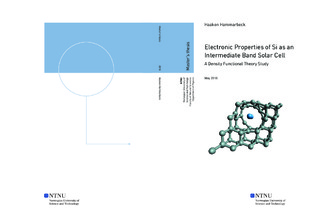| dc.description.abstract | Crystalline silicon is widely used as a solar cell material in modern day society. This report investigates the possibility of adding an additional energy band placed within the conventional band gap, in order to increase the efficiency of crystalline Si solar cells. Using density functional theory to calculate the electronic structure and finding the density of states along with the Fermi level, the electrical conducting properties of the material are determined. Si in the cubic diamond lattice was used with W and Ag as dopant atoms. Several doping concentrations and unit cell configurations were used with doping concentrations ranging from 25 % to 0.78 % (4-atomic to 128-atomic unit cell). Removing Si-atoms without replacing them with anything was also done, leaving vacancies in the lattice, to mimic more realistic conditions. Using different functionals and basis sets on pure Si and comparing with experiments, the Perdew-Wang 1991 functional was found to give the best results when weighing numerical accuracy vs. computational time. Adding a Hubbard term in the Hamiltonian to further increase the band gap description was tested but turned out to break important physical symmetry properties. The Hubbard term was therefore omitted when analyzing the many impurity configurations.
For the systems ranging in unit cell size from 2 to 16, DFT geometry optimizations were run. For the systems ranging in unit cell size from 32 to 128 including Ag, DFTB geometry optimizations were done and DFT energy calculations were done on the optimized geometry. For the systems ranging in unit cell size from 32 to 128 including W, MOPAC geometry optimizations were done and DFT energy calculations were done on the optimized geometry.
W-doped Si with a doping concentration of 0.78 % proved to form an intermediate band of width 0.55 eV lying 0.15 eV above the valence band edge.
The total band gap of this material was 1.38 eV. It should be noted that most of the results of this thesis is of limited quantitative significance, as DFT is known to underestimate the band gap for solids, and the MOPAC method is a semi-empirical method. The results from this thesis can only point out trends, not accurate results, and the systems that showed tendencies of an intermediate band should be investigated further by higher accuracy DFT calculations and cross-examined by other methods. | |

